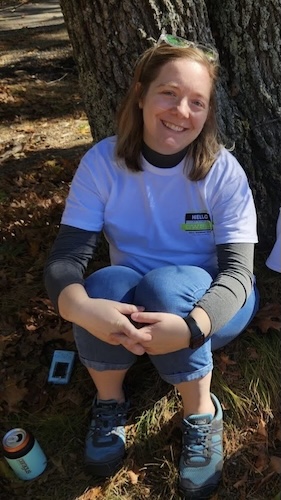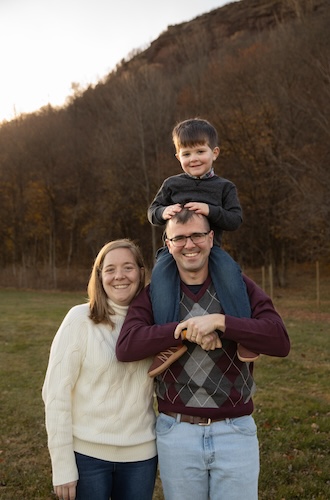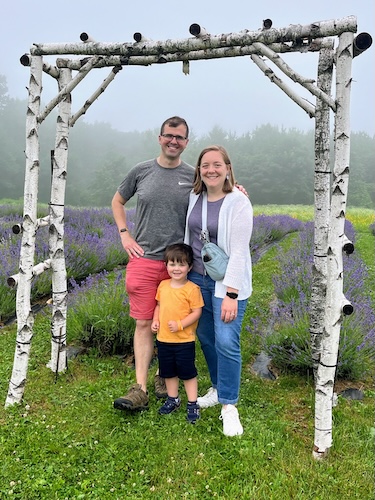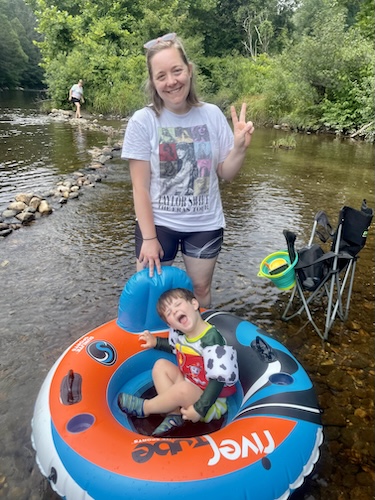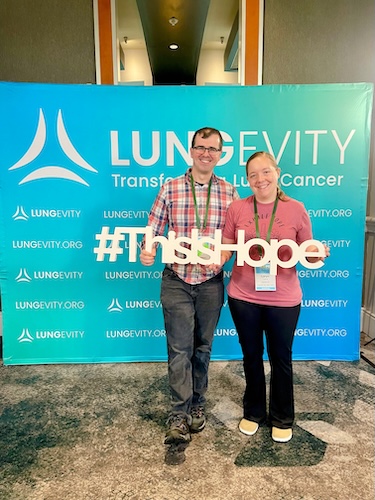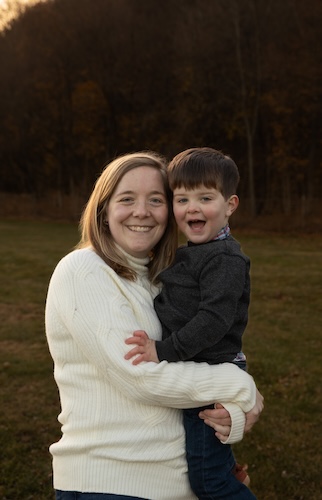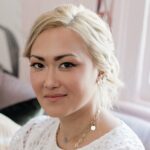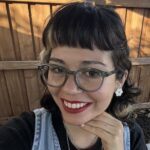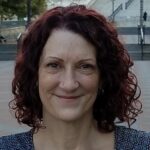Lung Cancer in Young Adults: What Loryn’s Stage 4 HER2+ Lung Cancer Story Can Tell Us
Loryn found herself in strange and unwelcome territory when she was diagnosed with stage 4 HER2+ lung cancer at 34 years old. Because she doesn’t have any known risk factors for lung cancer, her story is a powerful reminder that anyone with lungs can get lung cancer, even those who are young, healthy, and active.
Interviewed by: Nikki Murphy
Edited by: Chris Sanchez
Loryn’s experience started with symptoms that seemed easily explained: exhaustion, back pain, and later, chest discomfort. As a busy mom to a toddler, she chalked these initial symptoms up to lack of sleep and parenting fatigue. After multiple visits to the emergency room, she was diagnosed with pneumonia, which didn’t raise any red flags with her doctors. The small nodules discovered during her scans were dismissed as too minor to worry about, especially given her clean health history.
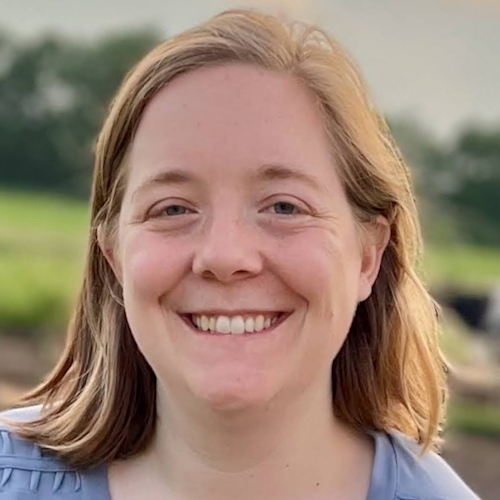
For four long months, Loryn went back and forth between specialists, was tested for autoimmune conditions, and endured intensifying pain. It wasn’t until a final ER trip that she learned that her cancer had spread to her bones and liver. This diagnosis was all the more unsettling because she was alone when she received it.
What followed was a crash course in self-advocacy. Biomarker testing, which wasn’t even mentioned at her original hospital, turned out to be crucial. A second opinion at Massachusetts General Hospital made all the difference. There, she finally felt seen and heard. Her new oncologist jumped into action, ordering a liquid biopsy to expedite treatment planning.
That’s when HER2 entered the conversation. While HER2 mutations are rare in lung cancer and don’t yet have as many targeted treatments as others, Loryn found hope in research, clinical trials, and the growing HER2 support community. She’s now receiving targeted therapy through infusions every three weeks and, despite the challenges, her quality of life has significantly improved.
Loryn is passionate about spreading awareness. Young, healthy people with no risk factors can get lung cancer. She encourages everyone to push for biomarker testing and get second opinions. She wants patients to feel empowered to say no to what drains them and yes to what preserves their health, dignity, and identity.
While her condition is incurable, Loryn views her cancer as something she can live with meaningfully. With support from her care team, loved ones, and online HER2 groups, she’s focused not on the what-ifs, but on each good day she gets to live fully.
Watch Loryn’s full interview and scroll down to read the transcript of her interview to find out more about her story:
- Why having no risk factors didn’t protect her from a stage 4 HER2 lung cancer diagnosis
- How repeated delays and overlooked symptoms kept her from answers, and what finally led to the truth
- The moment one ER visit turned into life-changing news
- What she wishes everyone knew about biomarker testing and second opinions
- How she found strength in saying no to what drains her and yes to what matters
- Name: Loryn F.
- Age at Diagnosis:
- 34
- Diagnosis:
- Non-Small Cell Lung Cancer (NSCLC)
- Staging:
- Stage 4
- Mutation:
- HER2
- Symptoms:
- Extreme fatigue
- Persistent back pain
- Chest pain
- Joint pain in the feet, hips, legs, shoulders, and elbows
- Treatments:
- Chemotherapy
- Radiation therapy: foot and elbow to help with mobility
- Antibody-drug conjugate
This interview has been edited for clarity and length. This is not medical advice. Please consult with your healthcare provider to make informed treatment decisions.
The views and opinions expressed in this interview do not necessarily reflect those of The Patient Story.
- Hi, my name is Loryn
- When something first felt off
- The reason my symptoms were dismissed
- The moment everything changed
- How I learned about biomarker testing
- How getting a second opinion helped my diagnosis
- Learning more about my biomarker
- What my treatment plan looked like
- My advice around biomarker testing
- I’m currently on a targeted therapy
- How I’m navigating life with stage 4 cancer
- Where I’ve found support
- Why there's hope around clinical trials
- What I want others to know
Hi, my name is Loryn
I live in Massachusetts. In November 2024, I was diagnosed with stage 4 non-small cell lung cancer with a HER2 mutation.
My friends would probably describe me as very loyal, consistent, and reliable. I’m pretty unchanging. I’ve been the same way my whole life, so I feel like I’m a go-to person, even by my parents, for thoughts and opinions.
When something first felt off
The first time I started experiencing symptoms that I can point to and say that it was definitely the cancer was in June 2024. I was experiencing extreme fatigue and back pain. I attributed it to working too hard and not sleeping well. I have a three-and-a-half year old, who was two at the time, so I thought that every parent was this tired and I probably pulled a muscle picking him up.
It wasn’t until the back pain started getting worse and I was having chest pain that I decided to go to the emergency room. At the time, all they saw were some small nodules, nothing big or concerning, so they diagnosed me with pneumonia, prescribed antibiotics, and sent me on my way.
Two weeks later, the pneumonia still hadn’t resolved, so I went back to the ER. They said it still looked like pneumonia, but the fact that it hasn’t resolved is concerning, so they referred me to a pulmonologist. The pulmonologist said that it wasn’t concerning as well and I didn’t have any risk factors to indicate that I needed further testing. They were on the path of wondering what could be causing the pneumonia. They thought it may be an autoimmune disease or something viral.
Then I was sent to a rheumatologist and while I was waiting for that appointment, I started experiencing joint pain pretty much all over my body. I felt it in my feet, my legs, my hips, my shoulders, and my elbows. After calling my doctor, I went back to the ER and that’s when they saw that my cancer had metastasized to my bones.
The reason my symptoms were dismissed
My doctors and I didn’t think the symptoms I had were serious enough to warrant doing more. I knew I didn’t feel good, but I was trying to toughen up and thought I was being dramatic. My husband said, “The doctors are saying you’re fine, but you can’t get out of bed and you’re struggling to keep up with our family.” We love to hike and go for walks, so it was odd that I changed so quickly.
I made a million excuses for why I was feeling the way that I was. I also tend to be an optimist, which definitely worked against me in that maybe I didn’t take myself seriously enough. I’m the type of person who’d say I’m fine, I’m okay, and I can work through it. Maybe I didn’t advocate for myself as strongly as I could have or should have.
My doctors only saw the small nodules. They were all smaller than 2 mm at the time. They described them as ground glass nodules (GGNs). They definitely had some bias as well because I was a nonsmoker and didn’t have any other risk factors.
During the first meeting with the pulmonologist, he ran through so many different questions about my work history, where I grew up, and if I had a wood stove at home. I think he was trying to find a reason to do a biopsy, but there was nothing that he could point to and say that could be something, which I think why the autoimmune route made the most sense.
Unfortunately, one of the tests came up positive. It didn’t necessarily mean that I had an autoimmune disease, but because I got a positive result, he said, “Let’s go this route and see what happens.” It definitely delayed things. It was four months in between my first ER visit and the last one when I was diagnosed.
The moment everything changed
On the day that I went to the ER and they gave me the news, I was by myself. Again, I downplayed it. At that point, my ribs were hurting a lot. I coughed and thought that I broke a rib. I texted my husband while I was at work and said, “Hey, I’m in a ton of pain. I’m going to the ER again and see if they can give me some pain medication.”
My husband even asked if I needed to go to the ER again because the bills were stacking up. I’ve had multiple CT scans and X-rays at that point, and they hadn’t found anything. I said, “Even if it’s just to get pain medication, I think I should go and get checked out.” I was even smiling and laughing through the whole visit. Even the ER doctor thought I probably bruised something and that I didn’t have a broken rib.
I did a chest X-ray and when he came back, he looked shocked. He said, “I hate to have to tell you this, but we’re seeing evidence of metastatic disease on your X-ray. We can see it in your ribs, shoulders, and liver. We’re going to do a CT scan, but we’re going to have to send you to another hospital because it looks like something more serious.”
I texted my husband immediately and said, “Whatever is happening looks like it’s getting worse. They mentioned metastatic disease.” My mind immediately went to cancer. My husband called my mother-in-law to watch our son then he came down to the hospital.
They transferred me to a larger hospital and kept me in for a week to do a biopsy of one of the lesions that they saw. They said they could have discharged me, but I would have had to wait a month for the biopsy. I wanted to know what this is and I didn’t want to lose my place in line, so I stayed inpatient for a week waiting for the biopsy.
The whole process took a while. They were afraid to call it anything. What they saw in my lungs still wasn’t huge. The nodules were still pretty small but because they were seeing it everywhere, they said whatever it is looks like it’s something that’s possibly stage 4, but they don’t know where it’s originating from.
We did the biopsy a week later and I was called with the news two days after. We knew the news was coming, but we weren’t sure how it was going to come, so I was home alone when I got the phone call. It was very quick and cold. The person said, “Hi, this is so-and-so from the cancer center. I’m calling to let you know that the results of your biopsy show that you have stage 4 lung cancer.”
It was pretty shocking. At that point, I had a full emotional reaction to what I was going through. I called my husband and told him to come home. Because in my mind, when I heard stage 4 lung cancer, I thought that I had weeks to live. I thought I was going to end up on oxygen.
The picture of lung cancer that I had was a very basic one. I had never known anyone with lung cancer, so I knew what I knew from TV and thought that I was going to deteriorate quickly. It was pretty devastating news to get because I didn’t know what lung cancer was.
There was no cancer center at the original hospital whose ER I went to. They were limited in what they could do and didn’t have any oncologists or any specialists on staff, so they transferred me to a sister hospital with a cancer center. But even then, the wing that I was at was pretty small. The week-long stay was a little scary. Everyone else who was being treated was much older and much sicker than I was. It felt like, “Why am I here? What’s happening that warrants me being in this position?”
How I learned about biomarker testing
They didn’t talk to me about it, at least not that I remember. While I was at the hospital, they talked about the biopsy and why they were doing it. They did the biopsy from my liver. They said that from that, they could tell where the cancer had originated from to be able to properly stage it and diagnose. But they never mentioned any gene testing.
It wasn’t until that phone call that I received then I called my husband to come home right away. I was in such an emotional state that I couldn’t do anything.
My husband called the surgeon that did my biopsy to get more information. When they originally called me, I tried to ask questions and they told me I would have to wait two weeks to see an oncologist to ask any additional questions. I shut down at that point, but my husband said, “No, we need some answers. We can’t sit here for two weeks with no information.”
I know now that they didn’t want to do anything for two weeks because they were waiting for the results of the gene testing, but I didn’t know that then because they didn’t mention it to me. When my husband called the surgeon, he brought up that they already sent the sample out for gene testing. He sent my husband a PDF file with information on lung cancer, which included what biomarker testing was, what the biomarkers could be, and what the next steps could be from there.
I read through that file before I heard anything further. It didn’t go into too much detail about HER2, which was what I ended up being diagnosed with. There was one quick mention of HER2 in the section that talks about what to do next and that there aren’t any targeted treatments for HER2. There’s traditional chemotherapy and that was it.
At that point, we felt that we weren’t getting the attention that we needed or the answers to our questions, so we decided to seek a second opinion at another hospital.
My husband’s brother is a doctor at Massachusetts General Hospital in Boston. After the experience that we had, my husband texted his brother, even though he’s not an oncologist, to ask him where we should go. His brother told us to come to Mass General and that they could get us in as soon as possible. He knew someone in their young adult cancer program and he reached out to that person for an introduction, and they were able to get me in in two days.
We lucked out that we had a connection there. Although from my experience, they are very quick at that hospital I had known about the Dana-Farber Cancer Institute, so I was in-between the two hospitals. I hadn’t connected with any support groups. I didn’t know anybody else yet.
In the first meeting at Mass General, we had a positive connection with the oncologist, so I was encouraged. We connected on a very personal level, so the decision to stay at Mass General was easy. I wanted to be somewhere where I trusted the doctors who I was working with, who I felt comfortable talking with, and where I felt that they had a personal connection with us as well.
How getting a second opinion helped my diagnosis
At the first meeting that I had with my oncologist, she talked in depth about biomarker testing, even though we didn’t know yet that I had HER2. She opted to do a liquid biopsy as we were waiting on the tissue biopsy because she wanted to get the ball rolling as quickly as possible after she looked at my scans and saw how advanced the disease was.
She did let me know that the liquid biopsy isn’t always as accurate as a tissue biopsy so if the liquid test came back with nothing, then we would wait for the tissue biopsy results. Luckily, the liquid test did come back with the HER2 mutation.
We had another meeting the day after the results came back where she went through HER2 and what that meant. She was very honest that there aren’t as many options for HER2 right now, but that there are many clinical trials available and that she was going to make sure that I had access to as much research and science as she could provide.
We moved very quickly into the treatment stage. I did a little bit of research about biomarkers and hoped that I had one that was a little more prominent, so I didn’t know as much about HER2. She answered all the questions that I had about HER2 and I felt comfortable with her answers.
She even let me know that she was part of a research project that was happening on HER2, which was encouraging. It made me feel a lot better about having a HER2 mutation, but it was shocking when I first heard that that was what I was going to be dealing with.
Learning more about my biomarker
I made the mistake of Googling HER2, which, looking back, I wish I hadn’t done. The information out there about HER2 is pretty dated. The first thing that Google told me was that it’s very rare, that the prognosis isn’t as great because there aren’t as many options, and that it tends to be a more aggressive mutation.
I was disappointed and scared. I still didn’t know as much about lung cancer. I was trying to learn as fast as I could, but I still had the mindset of not having much time left. With this rare and aggressive mutation, it felt like everything was stacking against me and that there was no good news coming in. Everything that we were hearing was negative.
But I trusted what my oncologist was telling me. She told me, “Don’t Google anything,” but it was already too late. Looking back to those first weeks from diagnosis until I started treatment, it was pretty depressing. I was holding off on some information from extended family because I didn’t want them to know how dire things felt. Everyone was feeling it, though, not knowing what was going to happen.
What my treatment plan looked like
The first treatment felt like it was the only option. My oncologist let me know that in order to be eligible for other options, I had to do this chemotherapy regimen first as it’s the only first-line treatment option. I’m sure if I pushed a little bit, maybe there could have been something else there, but it was presented in a way that made it seem like this was the only option. Then once this fails, we could talk about the next steps.
I was put on traditional chemotherapy. She was very honest that she wasn’t expecting it to last for very long. Optimistically, I would get six months on that treatment line. I was trying to mentally prepare for that.
Trying to explain that to family was a little tricky. Once you start cancer treatment, most people ask how long you’re going to be on treatment until you could stop. They look for the end goal. For me, it was just a necessary evil to get to something better.
We were able to start treatment pretty quickly. I started about a month after my initial ER visit. They moved quickly.
My advice around biomarker testing
I lucked out because I was in a place where they took biomarker testing seriously. At my first hospital, they weren’t as good about communicating that with patients, at least not in my case. It might be a lack of information or the doctors whom I was working with.
As I’ve been in this community, I’ve seen patients who are not offered any biomarker testing and put right on chemotherapy, so it’s still happening. I wish more people knew about how important biomarker testing is to knowing what your treatment options are and to have a full view of what the future might hold for the specific cancer that you have.
Even when you Google some of the cancer types, biomarker testing doesn’t come up most of the time. I try not to Google anymore, so maybe it’s getting better, but it certainly didn’t come up in my initial research.
Some of the larger hospitals are starting to push that information. People are getting better about getting second opinions, too, which is great. It’s part of your right as a patient. If you don’t feel that what you’re hearing is helpful, pushing for that second opinion is important.
My treatment was the standard of care for HER2 and the only option at that time. Since then, other options have started to become more standard of care. I was on that regimen for two and a half months before I had progression, so I didn’t get as far as the six months that my oncologist had hoped. The conversation then went to what the other options were and I was presented with more directions that I could go.
I’m currently on a targeted therapy
I started my targeted therapy in March 2025, which is an infusion every three weeks. A lot of oral targeted therapies are starting to come out, which is amazing. I’m excited for that to hopefully become a more standard option for HER2 in the future.
Right now, I’ve learned to manage having an infusion every three weeks. The first week after an infusion is a little rough with fatigue and nausea. I get some body aches as well, particularly where my lesions are.
I’ve gotten so much better from when I first started. My quality of life has improved so much between infusions. I feel more like my old self before any of my symptoms started. My bone pain has gone away. The liver pain is much better, as well as my blood work. For a long time, my liver enzymes were elevated. They were worried about my liver function, but that has since improved.
I live my life normally for two weeks and then I go back for my infusion. We plan our lives around the one week that I’m not feeling well. We get childcare and still have family and friends who reach out to help us as much as they can. It feels like I hibernate for a week and then I’m back to my old self, which is great.
I’m grateful for this treatment option that I’m on and, hopefully, I get to be on it for as long as I can. My oncologist is hoping that I get a year on this treatment and has prepared for what that next step after would be.
How I’m navigating life with stage 4 cancer
It’s tricky. For a while, I was dealing with other health issues. After I’d given birth to my son, I had to have an emergency gallbladder removal and dealt with digestive issues for about two years before my cancer symptoms started.
It felt like everything bled into one another, which I think contributed to why it took so long for me to be diagnosed. My primary care doctor probably had that in the back of her mind and felt that everything was an extension of my gallbladder removal from three years prior. The last time that I was truly healthy was in 2020 and I’ve been having health challenges since then. One day, I’d feel good; the next day, I’m not.
If I dwell on it too long, it gets to me. Typical 30-something-year-olds are planning their lives, building their families, and have these goals that they’re trying to attain, whereas my goal sometimes is to just get through the day. I try to look forward to vacations and hobbies, but it’s certainly not as it used to be five years before. Things have changed so drastically.
The perspective that cancer has given me has been to enjoy the day-to-day things that I have the privilege of having. For a time, I wasn’t sure that I was going to have those things anymore. I was barely walking when I was first diagnosed. I had so much pain in my hip and my leg. I thought I was going to be in a wheelchair, if I even made it that long.
I feel grateful for all of the mundane things that I get to have, but it can be challenging being in circles with parents of small children who are making these big plans for their kids’ future. I’m just hoping to make it to the point where I see my son get to do those things. I certainly don’t have some of the complaints that parents have. I might have them deep down, like the stressful days and temper tantrums, but I try to be grateful instead of being brought down.
It’s weird to say that, but I am grateful to the illness that I’ve been diagnosed with for giving me that perspective. Before I was diagnosed, things were just hard and I didn’t have a title to put on the pain that I was feeling. My husband and I struggled because I didn’t have energy and I was always going to the doctor. It was affecting our marriage, my relationship with my son, and my working relationships.
Finally getting to call it cancer and start treating it opened everything up for me and has changed my attitude. It’s changed me mentally. It’s weird to say that you’re grateful for cancer. I try not to dwell on the hard parts and the disappointing parts. I try to be grateful that I can move forward. Hopefully, research keeps up with me so that I can keep living the life that I have.
Where I’ve found support
We have a Facebook support group for HER2 patients. It’s not a huge group, but I have formed strong friendships with other HER2 patients. We check in with each other and have little group chats to talk about what we’re feeling. We’re watching the clinical trial field and being excited together for the things to come. I try to keep the cancer support within those support groups.
The friends that I have in my personal life came to me early on and said, “What do you need for support? How can I best support you?” I told them that I wanted to keep living my life normally as a 34-year-old. I want to hear about their lives and the things that they’re going through. It was important to me for them to ask me about the non-cancer parts of my life to maintain that normalcy.
Early on, I told my oncologist that I wanted to fight my cancer as hard as I could, but I didn’t want to lose myself in cancer treatment. I didn’t want to just become a cancer patient and the side effects to change who I am. She assured me and connected me with palliative care and other support resources to make sure that I could maintain the same quality of life that I have.
I’ve come to terms with my cancer pretty well. Having it described as a chronic illness and managing it like any other chronic illness, where you’re on treatment and you’re going to have good days and bad days, was helpful. Having to explain that to other people has been difficult, though.
People like to have goal posts, whether they’re someone who prays for you or someone who wants to support you in some way. People have asked, “How long are you going to be on treatment for?” When I have to tell them that it’s indefinite, you see the disappointment in their face, which affects me too.
In the beginning, we had so many people who came out to help us. We had people who were cooking for us, helping us financially, and helping watch our son for us. Everything was thrown at us to help us through this tough time. We had to tell everyone that these “tough times” are going to continue. It’s going to get easier in the sense that we manage it better. Hopefully, my health improves to a point where I can contribute to things again and I can walk again.
Cancer is always going to be a part of my life, so we’ll need consistent support from our network. Some of that support has died down quite a bit, but people have learned to support us in ways that are useful long-term. The struggle is trying to manage other people and their expectations of cancer. I don’t think people see it as like a long-term illness. They see it as short-term. Either the cancer is resolved and you’re healed or it doesn’t and you pass away. They don’t see the in-between of cancer.
Why there’s hope around clinical trials
I’m so encouraged by clinical trials. At night is when the cancer thoughts sink in. It’s usually hardest when I’m trying to fall asleep and those thoughts swirl around. I tell myself that there’s someone alive right now who’s working on medications that are going to keep me alive or working on a cure for lung cancer. Those keep me going, whether or not it’s happening and going to be here tomorrow. The fact that it could be here in my lifetime keeps me going.
Even if I don’t get to see the cure for lung cancer, it’s feeling more attainable. Research is making lives for cancer patients easier, longer, and improving their quality of life. It makes me so happy for the future of lung cancer. I’ve heard the same from people who have been dealing with lung cancer for five or 10 years. Things have changed so much just in the last five years. To see where things might be five years from now is where I’ve put my goal post.
We’ve only had access to the drug that I’m on now for the last two or three years. Things can change so rapidly. I try not to get stuck in all of the things that we don’t have and focus on the things that we do have. That’s where I find my hope in research.
What I want others to know
Advocate for yourself. If I’m feeling any pain or extreme nausea, I immediately bring it up to my doctors. A year ago, despite being in so much pain, so tired, and suffering, I was afraid to bring those up and be seen like a baby or a wimp. I can safely say that I’m not that way anymore. If anything is getting in my way of being happy and healthy, I bring it up with my care team. They’re always more than happy to help and to adjust my drugs or offer other treatment options.
Be honest about how you’re feeling, how it’s affecting you, and the things that you can and can’t do. Our medical system is not built in a way that people are going to check in with you, so you have to check in with them.

Inspired by Loryn's story?
Share your story, too!
More Non-Small Cell Lung Cancer Stories
Laura R., Non-Small Cell Lung Cancer, ALK+, Stage 4 (Metastatic)
Symptoms: Persistent cough, fatigue, bone pain
Treatments: Targeted therapies (tyrosine kinase inhibitors or TKIs, including through a clinical trial)
Drea C., Non-Small Cell Lung Cancer, ROS1+, Stage 4 (Metastatic)
Symptoms: Swollen ankle resulting from a deep vein thrombosis or blood clot, mysterious bruising, extreme weight loss, persistent shortness of breath, rattling sound coming from the throat while breathing
Treatments: Radiation therapy, chemotherapy, targeted therapies
Lysa B., Non-Small Cell Lung Cancer, ROS1+, Stage 4 (Metastatic)
Symptom: Severe but intermittent back pain
Treatments: Chemotherapy, radiation therapy, targeted therapy (including through a clinical trial), surgeries (lung resection, metastatic spine tumor surgery)
Ashley C., Non-Small Cell Lung Cancer, HER2+, Stage 4 (Metastatic)
Symptoms: Fatigue, breathlessness, persistent back pain, multiple rounds of bronchitis
Treatments: Chemotherapy, targeted therapy
